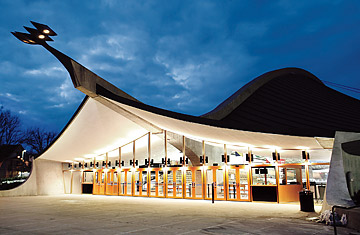
Yale's Ingalls Rink is Saarinen at his most voluptuous.
(2 of 2)
The Drama of Powerful Forms
Saarinen was a Modernist by birthright. His father Eliel was a Finnish architect whose radically clean-lined entry in the 1922 competition to design the Chicago Tribune Tower took second place in the contest but first place in history. For a rising generation of architects, that unbuilt proposal was an arrow pointing straight to the future and a strong influence on the Empire State Building and Rockefeller Center. The fame it brought the elder Saarinen in the U.S. persuaded him to emigrate the following year from Finland to Chicago. A few months later, his wife and children, including his precocious 12-year-old Eero, joined him.
The most important project of Eliel Saarinen's American career was Cranbrook Academy, a school of the arts situated on the estate of a wealthy patron in Bloomfield Hills, Mich., where the Saarinens soon relocated. In his teens, Eero worked occasionally on projects in his father's studio. From early in his career, the younger Saarinen's buildings grew out of the Modernist principles of simplified form and clearly expressed structure. But soon he was looking for ways to move beyond the arctic purities of Modernism's first generation. Mies van der Rohe and Le Corbusier had done what they could to cancel architecture's debt to the past and remake it from a kind of formal and historical ground zero. The second generation — of which Saarinen was a part, along with Philip Johnson, Louis Kahn, I.M. Pei and Edward Durrell Stone — would struggle in different ways to reconnect architecture to its sources in history.
They would also struggle to accommodate it to the appetites of postwar America, an abundant, full-of-itself nation. The country's corporate and institutional élites were open to the idea of seeing their power expressed in a contemporary idiom, with none of the grand and intricate ornament of earlier generations. Yet the bare-bones Modernism that came of age in Europe between the wars was not quite what they were looking for.
In Saarinen they found a man who operated in their sweet spot. His work had the richness and lyricism that so many Modernist buildings lacked. At the same time, he had taste and intelligence. He wasn't about to give them the kind of thing suited to Vegas casinos and Miami Beach hotels. For the most part, the wow factor in his buildings was a matter of structure, not sparkle. Saarinen was enchanted by the drama of powerful forms. His mother was a sculptor, and he had studied sculpture before switching to architecture. The massive curve of the Gateway Arch, the muscular reach of the tilted pylons of Washington's Dulles International Airport, the black-granite palisades of the CBS headquarters, his only skyscraper, a thing that appears to shoot skyward from the bedrock of Manhattan — these are works of an architect, like Gehry and Calatrava today, who was thinking in sculptural terms.
All the things that pure Modernism excluded from architecture, including symbolism and psychology, Saarinen brought to his TWA terminal. With the wide concrete wingspread of its flaring roof, it resembles a bird in flight. But more than that, it has an almost maternal quality, one that's re-emphasized by the Fallopian coils of the stairways inside. And the long enclosed tunnel that passengers had to walk from the main terminal to the gates — isn't that like a birth canal leading you to the moment you are launched into the sky? This is, after all, the man who invented the Womb chair.
The Greeks called architecture the mother of all arts. Maybe it took Saarinen to show how true that was.
